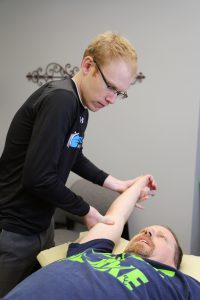by Troy Vander Molen, PT, DPT
 The shoulder is one of the most overlooked yet complex structures in the body. Basic movements like reaching up, washing your hair, opening your car door, or picking up your child or grandchild seem pretty simple until your shoulder hurts. Then you realize how important your shoulder is and how difficult it is to enjoy life when it doesn’t behave properly.
The shoulder is one of the most overlooked yet complex structures in the body. Basic movements like reaching up, washing your hair, opening your car door, or picking up your child or grandchild seem pretty simple until your shoulder hurts. Then you realize how important your shoulder is and how difficult it is to enjoy life when it doesn’t behave properly.
When we help our many clients overcome shoulder problems, often they’ll tell us, “I didn’t realize how much my pain was really impacting my daily life!” We get used to pain don’t we? A little twinge here or there, and we think it will go away. We ignore the problem until it snowballs and our day to day life revolves around our pain.
The shoulder joint is extremely complex! Being one of the most mobile joints in the human body, you can imagine how important it is to keep it healthy!
There are 5 common reasons you might be having pain:
- Shoulder Impingement: The muscles and tendons in the shoulder are being
- Bursitis:The bursa (fluid filled sac) that provides a cushion to crucial shoulder tissues becomes swollen and inflamed and actually increases pressure on those tissues.
- Rotator Cuff Tears: A tear in any one of the four small but important muscles surrounding the shoulder that position the ball efficiently on the socket.
- Labral Tear:The ball and socket joint of the shoulder is a little like a golf ball sitting on a tee. The socket is small relative to the ball. The labrum is ring of cartilage around the socket that gives it a little more depth, and when it tears there can be much pain.
- Arthritis: The shoulder joint becomes stiff/painful due to degenerative changes.
 All of these conditions have unique findings and unique treatment strategies, but they all have one thing in common: the complex movement of the trunk, shoulder blade, and upper arm must occur efficiently. If a limitation of one of these important segments in the kinetic chain exists, another tissue will be stressed.
All of these conditions have unique findings and unique treatment strategies, but they all have one thing in common: the complex movement of the trunk, shoulder blade, and upper arm must occur efficiently. If a limitation of one of these important segments in the kinetic chain exists, another tissue will be stressed.
While treatments like ultrasound, elastic taping, and electrical stimulation can help reduce pain, they do not fix the problem. The key to successful treatment is to find and improve the movement dysfunction.
If you’d like to figure out why your shoulder is hurting, call the experts at Kinetic Edge Physical Therapy. We would love to give you a test drive for free. Just email us or call 866-588-0230 to ask for our complimentary 20-minute screen with one of our shoulder experts, and we can help you understand the real problem behind your pain.



